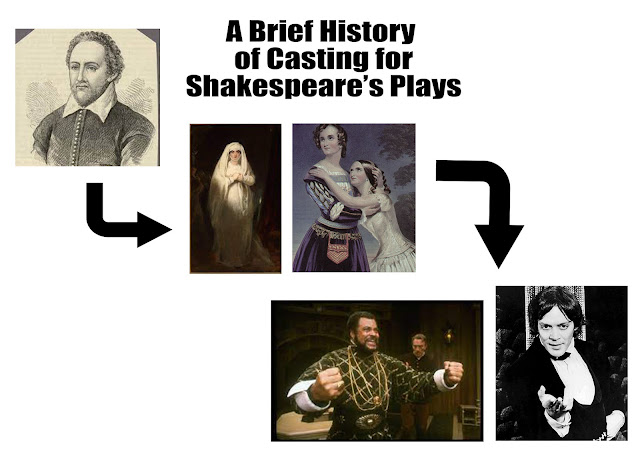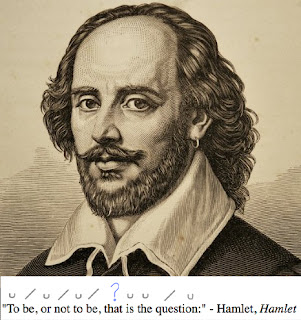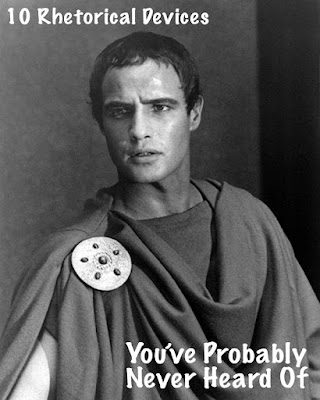A Brief History of Casting for Shakespeare's Plays
Shakespeare's plays have been popular for centuries, and have seen lots of casting methods come and go. Let's take a look at a timeline of casting trends for Shakespeare's plays from the 1600s to today. This post is certainly not a comprehensive timeline, but points out some major turning points in casting trends.
The 1600s: All-Male Casting
During Shakespeare's lifetime and for quite a while beyond, all roles were played by white men. Female roles were adopted by boys or younger men who had higher voices to try to reach a feminine vocal pitch. The first known Shakespearean production to cast a female actor took place on December 8, 1660, in which a woman (scholars are not sure whom) assumed the role of Desdemona in Othello. Despite that first step, casting female actors in Shakespeare's plays did not become commonplace for a long time.
The 1700s: Mostly All-Male Casting
In the 1700s, casting for Shakespearean productions remained mostly the same as it had in the previous century. While some female actors were cast in Shakespearean productions here and there, the overwhelming majority of productions remained all-male. However, an important factor in casting began to emerge: fame.
The 1800s and Early 1900s: A Few Women Become Shakespearean Icons
At the turn of the century, one Welsh tragic women actor was growing very famous: Sarah Siddons. Adoration from her public gave Siddons the opportunity to play Lady Macbeth. Siddons interpreted the character differently from her male predecessors: she portrayed a devoted wife, distorted by ambition just like her husband, rather than a manipulative monster. Siddons even experimented with playing Hamlet.
Siddons paved the way for other iconic female actors of the 19th Century, including Charlotte Cushman, who played Romeo in 1845. Cushman was a trailblazer in other respects, too: she had lesbian relationships in private, and did not appear as traditionally "feminine" in public. In 1846, Charlotte starred as Romeo alongside her sister, Susan, as Juliet.
Parisian female actor Sarah Bernhardt accepted the role of Hamlet in 1899. Her performance, of a youthful and energetic Hamlet, gained her critical acclaim throughout Europe and the United States. Some critics, however, felt that Bernhardt--and the female actors that followed in her footsteps--were fundamentally incapable of understanding male drives and emotions.
Around the same time, the incredibly famous Ellen Terry chose a more traditional feminine public image, and portrayed many female roles in Shakespeare: Ophelia, Cordelia, Desdemona, Portia, Beatrice, and Imogen. Her fame only increased and she became the highest paid woman in Britain.
Danish female actor Asta Nielsen experimented with gender in her 1921 silent film Hamlet. She portrayed Hamlet as a girl who had been raised as a boy to preserve the royal bloodline. Hamlet experienced major box-office success, allowing audiences across the world to judge Nielsen's interpretation of Hamlet for themselves.
The Mid 1900s: The Rise of Color-Blind Casting in the USA
Against the background of the Civil Rights Movement in the United States in the 1950s, color-blind casting (in which casting choices are made without regard to race and skin color) in Shakespeare's plays surged. Black, Asian, and Latinx actors were cast in major roles--no longer only Othello and Caliban. Under the leadership of Joseph Papp, more than half of the productions of the New York Shakespeare Festival were cast color-blind. Audiences saw stars of Shakespearean drama--including James Earl Jones, Denzel Washington, Ruby Dee, and Raul Julia--in leading roles.
The Late 1990s: Experimenting with Gender
Neil Bartlett's 1991 production of Twelfth Night featured cross-gender casting (in which female actors play male characters, and male actors play female characters) in the characters of Viola, Sir Toby Belch, and Sir Andrew Aguecheek. For Barlett, the cross-gender casting was an expansion of the cross-gender casting of the 1600s (in which men played female characters).
The Early 2000s: More Accessible than Ever Before
In the early 2000s, Shakespearean roles are, in large part, more accessible than ever before. Many productions blend previous casting trends: color-blind and color-conscious casting, traditionally and non-traditionally gendered casting. As audiences have expanded their definition of diversity, new casting questions and trends appear: for example, should the role of Richard III be reserved for actors with physical disabilities? Even broader: how faithful should casting be to the text of a play?
 |
| From top left to bottom right: Richard Burbank, Sarah Siddons, the Cushman sisters, James Earl Jones, Raul Julia |
Please note: the comments below represent the views of the commenters alone, and not The Green-Eyed Blogger. The Green-Eyed Blogger is committed to publishing all non-spam comments for an open discussion.



I get the mostly female/girl-power casting now. As a writer it seems to exchange the author's vision with the directors. However, women mainly support the arts/buy books so...girl-power it is, for now. It will pass.
ReplyDeleteA really radical idea would be to cast all the females roles as dudes...lol...t'ain't gonna happen...